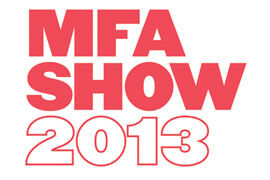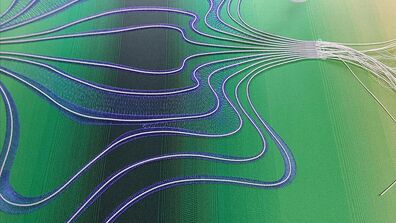
The State of Art

SAIC's 2013 MFA Show is one of the country's largest graduate thesis exhibitions, with more than 100 participating students, 12 graduate curatorial fellows, and three guest curators. The show is both a culmination of graduate work and a must-see presentation of contemporary art from the next generation of artists and designers. Here are a few of the voices involved:
Duncan MacKenzie (MFA 2002), Co-Producer of Bad at Sports and 2013 Guest Curator: The MFA Show process is interesting because everybody is part of the show, and everybody is amazing. Your job as a curator is knowing that there are more than 100 artists in the exhibition, and you know you can't possibly make all of their work make sense together or make some collective, cogent argument. So you set up relationships between the objects and make sure the works are speaking to one another and building on a conversation—rather than weakening each other with their own strengths.
Raven Munsell (Dual MA 2014), 2013 Curatorial Fellow: One key to curating a show is communicating well with the artists and making sure you make a space for them to present their work at its best.
John Paul Morabito (MFA 2013): The MFA Show is an excellent opportunity to take risks. We are given a professional gallery space to work with according to the interests of our practices. I can't think of a better way to engage the show than to explore the possibilities of presentation and really push boundaries.
Aram Han (MFA 2013), 2013 Curatorial Fellow: It's important to curate the artist and curator relationship and make sure the curator is supporting the artist. When I approach an artist, I take that stance: How can I help you? What works are you willing to show? Where in the space would you want to show? If it's next to such-and-such piece, the works will bring out such-and-such dialogue...are you okay with that? Is that something you want? So you need to be constantly in conversation.
Kim Harty (MFA 2013): I think the MFA Show is an opportunity to define and refine your voice. Being surrounded with such a diverse array of work that is functioning at such a high level, it forces you to be intentional about your presentation and really consider how your work stands out.
William Ruggiero (MA 2013), 2013 Curatorial Fellow: Curating involves a lot of time and talking, and it's not just one perfect conversation. There's definitely disagreement.
Gan Uyeda (Dual MA 2014), 2012 Curatorial Fellow: It's often assumed that curating is one action, but it's all of these mini-actions that lead up to the show.
Encarnación Teruel (Director of Visual Arts, Media Arts, and Multidisciplinary Arts Programs at the Illinois Arts Council), 2013 Guest Curator: The guest curator experience is almost like being invited into a lab—a science lab and a creative lab. We have a problem to solve and an equation to deal with and lab assistants to help. It's a specialized, informed lab—the institution has a lot of resources, and the students are versed in contemporary paradigms of curating, exhibiting, and art manifestations. It's exciting because I've been invited into this lab to experiment.
The experience has been enlightening to see what's happening in art in the 21st century at a school like SAIC. And because it is an institution, there is a lot of experimentation, development, and evolution happening. It's exciting to get all these different petri dishes and find out what they're doing.
Assaf Evron (MFA 2013): Since my work is open ended, the process of choosing and creating an inner dialogue between the works is crucial. So I'm excited to work with the MA curator and the curatorial team in order to bring new context and inner relations to my work.
Mia Lopez (Dual MA 2013), 2012 Curatorial Fellow: The biggest lesson I learned from my role as a curatorial fellow last year was how to be able to problem solve. Even with all of the planning in the world, you can't anticipate some of the issues that will come up when dealing with art and artists. The day before last year's MFA Show we had a piece that had found wood, and when we were doing our final walkthrough, we saw a very small insect—possibly a termite. So we had to determine if it was a termite, and if it was, we would have to throw out the entire piece and possibly fumigate the Sullivan Galleries. Fortunately it was an ant, and we just sprayed some bug spray on the piece. It was definitely a moment of panic.
Crystal Gregory (MFA 2013): So many schools treat the MFA Show as an ending, and SAIC treats it as a beginning. I see this as a jumping off point. Someone once told me something that I am beginning to understand and hoping to be true: "Grad school is not a two-year degree. It is more like a five-year program. It takes two years to gather information and three years to unpack everything you have learned."
Lisa Dorin (fmr. Associate Curator of Contemporary Art at the Art Institute of Chicago), 2013 Guest Curator: MFA shows are by nature unwieldy, and can often be so much visual overload. Since the exhibitions department has been honing the MFA Show process over the last few years by convening curatorial teams, I've seen the show getting stronger. I welcome the opportunity to be a part of its continuing development.
I hope that the fellows and MFA students learn how to talk effectively to each other and to work together as they begin their professional careers because the art world is a big morass of relationships to be built, negotiated, and maintained. Very little of consequence happens in a vacuum, so to be thrown together at this stage and begin to form those relationships is a really good learning opportunity.
